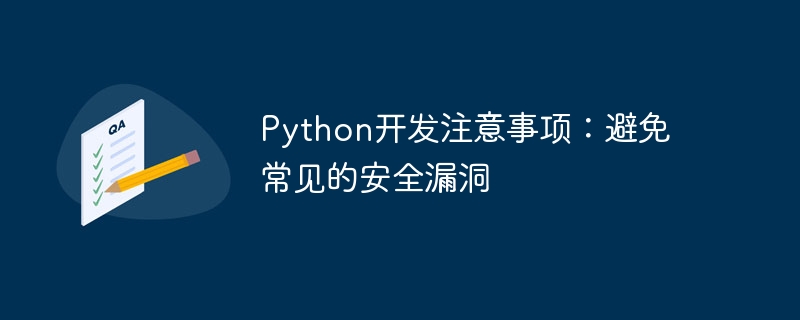Home >Backend Development >Python Tutorial >Python Development Notes: Avoid Common Security Vulnerabilities
Python Development Notes: Avoid Common Security Vulnerabilities
- 王林Original
- 2023-11-22 14:26:24991browse

As a simple and easy-to-learn programming language, Python is widely used in various software development projects. However, with the development of the Internet and the increasing importance of information security, developers increasingly need to pay attention to the security of their code. This article will introduce some common security vulnerabilities that need to be paid attention to during Python development, and provide some methods to avoid these vulnerabilities.
- Input Validation
Input validation is the first step in preventing many security vulnerabilities. Developers should always validate user input to prevent malicious input or unexpected data from causing security issues. For example, for database query statements entered by users, parameterized queries should be used to avoid SQL injection vulnerabilities. For the file upload function, the type and size of the file should be verified and the path for file upload should be limited. - Cross-site scripting attack (XSS)
Cross-site scripting attack refers to an attack method in which an attacker injects malicious script code and executes it in the user's browser. The best way to protect against XSS attacks is to HTML-encode all user-entered data. This ensures that user input is treated as plain text rather than executable code. - Cross-site request forgery (CSRF)
Cross-site request forgery means that the attacker uses the user to perform some unintended operations while logged in. To prevent CSRF attacks, a verification token (CSRF Token) can be used in each key operation. This verification token is associated with each user session and is verified during key operations to ensure that the operation is the true intention of the user. - Sensitive information leakage
During the development process, you should avoid storing sensitive information (such as passwords, bank accounts, etc.) in plain text in the database or transmitting it over the network. The best practice is to encrypt this information using encryption algorithms while ensuring proper key management. Also, make sure failure information is properly handled in your code and avoid exposing sensitive data. - Authentication and authorization issues
Authentication and authorization are key links to ensure system security. When designing authentication systems, developers should consider using password hashing algorithms to protect users' login information and avoid using weak passwords. When authorizing, user permissions should be bound to their roles and appropriate access control should be implemented. - Malicious package dependencies
In Python development, we often rely on third-party packages. However, third-party packages that are unsafe or contain malicious code may cause system security issues. Therefore, developers should regularly update dependent packages, also review the source code and documentation of these packages, and download these packages only from reliable sources. - Unsafe file operations
When performing file operations, we should handle file paths and file names carefully to prevent path traversal attacks. Use absolute paths or relative paths based on the project root directory to access the file system to avoid unnecessary security risks. Also, do not trust any file names or paths obtained from user input.
To sum up, Python developers need to always pay attention to code security. Proper input validation, encoding user input, using validation tokens, encrypting sensitive information, proper use of authentication and authorization, careful selection of third-party packages, and secure file operations are all key elements to ensuring code security. By adhering to these precautions, we can reduce many common security vulnerabilities and improve the security of the system to ensure the safety of users and data.
The above is the detailed content of Python Development Notes: Avoid Common Security Vulnerabilities. For more information, please follow other related articles on the PHP Chinese website!

